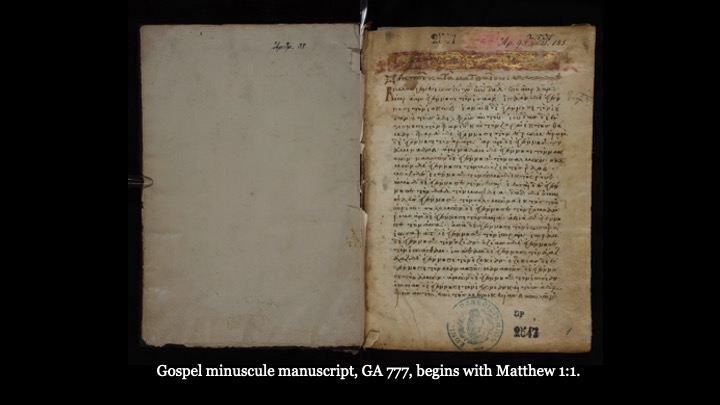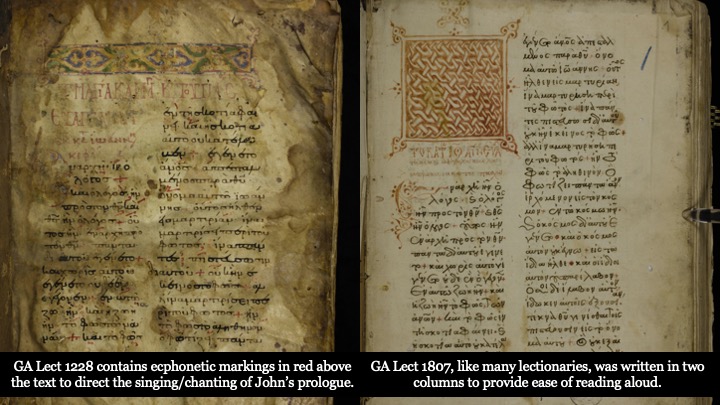By: Leigh Ann Hyde
The sun has just peeked over the horizon as a church in Byzantium commences a familiar and divine practice. A deacon solemnly walks from the altar through the north entrance around the nave and back to the altar from the central entrance. In his procession, known as the “Little Entrance,” the deacon carries a grand book. Its grand size and the reflection of early sunlight from the precious stones and metals worked into its cover draw every eye to the magnificent scene. A muted thump echoes in the reverential moment when he lays the book on the altar. On this day, Easter Sunday, the Presbyter, or leading church elder, approaches the grand codex. A deacon would serve as the reader for all other readings in the liturgical calendar. Today, however, the Presbyter reads the familiar words aloud from the page in front of him: Ἐν ἀρχῇ ἦν ὁ λόγος… “In the beginning was the word….”
Centuries later, hundreds of Gospel lectionaries—produced overtime for the church and study—stand on the shelves of libraries and monasteries around the world. Many of these impressive and unique books played an important role in Easter Sunday services throughout history. Lectionaries served a particular function in their world, making them a window for modern readers into the lives of those who first turned their pages. As we observe the Easter Sunday lections—or designated readings—held in precious Gospel lectionary books, we learn about how people celebrated the sacred day years ago. Even more, we have the privilege of participating in the long-practiced Easter tradition of reading and beholding the beginning of the lectionary readings for the year: John’s prologue.
Lectionary Sections and Calendar
Easter Sunday marks the first day on the Byzantine church calendar. The part of the lectionary that corresponds to the church calendar, otherwise known as the synaxarion, often falls at the front of complete lectionaries. Correspondingly, complete lectionaries begin with the Easter lection. The menologion, a section that accords with the civil calendar, follows the synaxarion section and begins on the 1st of September. Lectionaries, then, have a unique order reflecting the calendar instead of the canonical order of books.
While the order of books occasionally varies between non-lectionary manuscripts, lectionaries implement a different order altogether, based on liturgical readings for the church calendar. Comparing a Gospel book to a Gospel lectionary in the CSNTM Digital Manuscript Collection, the first page of the New Testament text differs. A continued reading of the two manuscripts would reveal the unique ordering of lectionaries compared to the other categories of New Testament manuscripts.


The Easter Lection(s)
Greek New Testament Lectionary readings for Easter Sunday include two readings: John 1:1–17, the prologue of the Gospel, titled τῇ ἁγίᾳ καὶ μεγάλῃ κυριακῂ πάσχα or “For the holy and great Lord’s day (Sunday) of the Passover” and John 20:19–25, the pericope of Jesus’ appearance to his disciples, titled κυριακῂ τοῦ πάσχα ἑσπέρας or “For the evening of the Lord’s day (Sunday) of the Passover.” In the manuscripts, readers find these texts accompanied by a variety of features such as the titles mentioned above, headers, ornamented letters, and icons.

Many lectionaries that begin with the Easter lection also contain evidence of the books’ function. Columns, headers, and liturgical markings served as readers aids and, therefore, signify the intended use for out-loud reading. Ecphonetic markings above text acted as music notes, informing the reader of rising, falling, and lengthening of words, creating a melodic chant of the familiar passage.

A great number of Greek New Testament lectionaries contain the Easter readings. Even more, the period from Easter to Pentecost held such importance in the liturgical calendar that a group of lectionaries contain readings for every day of that season while only containing Saturday and Sunday readings for the remainder of the year (the lesk group in the Kurzgefasste Liste). In the period from Easter to Pentecost, lectionary readings continue through the book of John with a few inserted pericopes about the time following Jesus’ resurrection from Luke and Mark. See GA Lect 435 and GA Lect 1964 for examples of this kind of lectionary.
Beyond the pericope’s position in a lectionary, ornamentation around the passage reveals the value of the text to those who read it. Some manuscripts even contain evidence of interaction with the text through notes written around the text or markings left after using the page.


Many students of the New Testament find passages to which they often return. Often certain frequented texts hold significance for celebrations, memorable events, and markers of important moments. For those who gathered around Greek New Testament lectionaries to celebrate Easter, the beginning and end of John would ring familiar in their ears, sometimes accompanied by melody or grand decoration. This Easter Sunday, you can join with celebrators from centuries ago by reading John’s prologue.
If you would like to read the Easter lection from a Greek New Testament lectionary in CSNTM’s Digital Manuscript Collection, search for lectionaries that contain John or choose one of these examples: GA Lect 185, GA Lect 217, GA Lect 220, GA Lect 224, GA Lect 261, GA Lect 291, GA Lect 345, GA Lect 384, GA Lect 387, GA Lect 434, GA Lect 1215, GA Lect 1225, GA Lect 1228, GA Lect 1529, GA Lect 1676, GA Lect 1802, GA Lect 1805, GA Lect 1967, GA Lect 1839.

